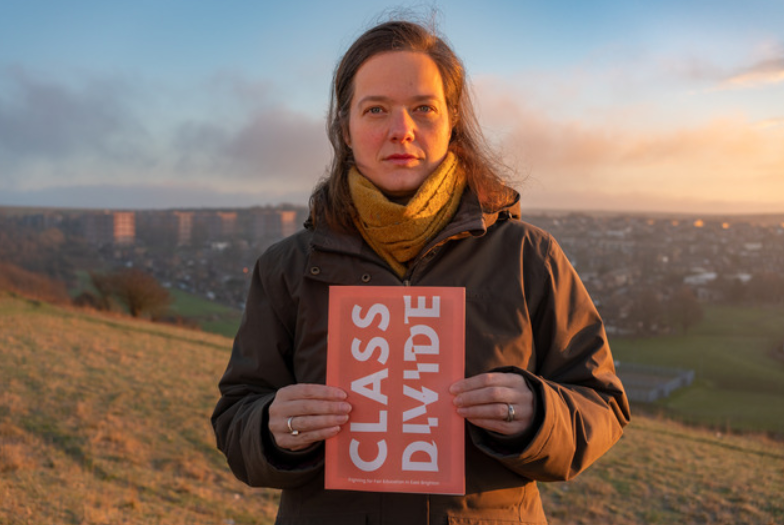A campaign group fighting for greater educational equality in Brighton and Hove has backed council plans to give pupils receiving free school meals a better chance of securing their first choice school.
Class Divide has spent the past three years calling for Brighton and Hove City Council to close the attainment gap for young people living on the city’s most deprived estates.
In the run up to the local elections earlier this year, Class Divide held a hustings event in the Whitehawk and Marina ward.
Labour candidate David McGregor, who is now a councillor, “committed to the change” to give children receiving free school meals a greater choice.
When the council proposed the change, Councillor McGregor posted on social media: “As someone that grew up on free school meals, I’m so proud of this Labour administration for introducing a policy to give kids on free school meals a greater choice in the school they go to.”
In recent years, secondary schools have been oversubscribed, with “bulge” years of primary school pupils moving through the education system. Now, intakes are expected to start shrinking.
And education chiefs are proposing to give youngsters on free school meals the third priority level when applying to secondary schools – after children in care and those with exceptional needs.
The proposals – due to be decided by the council’s Children, Families and Schools Committee on Monday (6 November) – are designed to balance out the percentage of pupils receiving free school meals.
Class Divide campaigner Curtis James said: “There is evidence of benefits to schools, to teachers, to quality of education if you’ve got a better mix of kids from different socio-economic backgrounds at school together.
“To me, there’s the obvious benefit of children from different backgrounds meeting on a societal level. The big one is around meaningful choice.
“There’s this idea that all parents have a choice of what school their children will go to. Whitehawk lost its secondary school nearly 20 years ago and, at that point, parents in BN2 5 lost any meaningful choice.
“We believe all families should have access to choice. It’s only free school meals kids, but it is a good beginning.”
Carlie Goldsmith, from Class Divide, said that the campaign understood that there needed to be a workable system for parents and schools.
Dr Goldsmith said: “This will make sure that essentially what we’ll have is all the schools in the city having at least the same percentage of children on free school meals as there is in the city in their cohort, which makes sense.
“We want a bigger social mix in schools and, at the moment, there are some schools where children on free school meals are heavily concentrated – and that isn’t a problem for children on free school meals. I was one of them.
“What does happen, with the current financial problems and economic context, is schools have to do an awful lot to make sure their pupils are in a position where they’re able to engage fully in the school day and learn.
“That places additional pressure on schools. Our schools are rising to the pressure but if you’ve got a good school, it’s good because you can teach all children.
“There are schools which are not representative of the city average.”
Class Divide is planning a podcast and events to encourage people to share their views both for and against the proposals should councillors agree to start a public consultation.
A report to councillors said that if 15 per cent of the pupils at a school received free school meals and the city average was 20 per cent, more pupils receiving free school meals would be likely to be offered a place.
The council expects the figure to reach 28 per cent by 2025 when the changes come into effect and when the council estimates that 60 fewer pupils will require a secondary school place compared with this year.
The percentage of pupils currently receiving free school meals in each secondary school is as follows
- King’s School 15 per cent
- Blatchington Mill School 16 per cent
- Cardinal Newman Catholic School 16 per cent
- Dorothy Stringer School 18 per cent
- Varndean School 19 per cent
- Patcham High School 20 per cent
- Portslade Aldridge Community Academy 28 per cent
- Hove Park School 32 per cent
- Longhill High School 36 per cent
- Brighton Aldridge Community Academy 46 per cent
The Children, Families and Schools Committee is due to meet at Hove Town Hall at 4pm on Monday 6 November. The meeting is scheduled to be webcast on the council’s website.








This is fantastic news. Can we call ourselves an inclusive city if our schools don’t reflect that?
Even better why not make the schools in deprived areas so good that people in more affluent areas wished they were in the catchment area for these schools.
I see the reasoning behind this, rather than good and bad schools, everyone is mediocre. I personally would like to see improvements made to all the struggling schools to bring the average attainment standard up. Diluting the issue doesn’t make it go away, in my opinion. While much research has been undertaken in the past 50 years, and we are fairly certain that socioeconomic background does have an effect on educational achievement, we are no closer to understanding how this effect is transmitted. Until we are, it will remain difficult to address.
So will this lead to even more out of area travel for pupils?
Can’t see many parents from “East brighton” travelling all the way across the city in their pyjamasto go to Kings
It’ll almost certainly create an increase in council costs through legally mandated free school travel.
But kids on FSM get free bus travel already, so it will not increase costs. All kids from East Brighton must travel out of the area as there is no local school.
You do not have to be in receipt of Free School Meals to be poor. When my father left my mother was.ked all over town to find a job. We didn’t have money to spare but we didn’t get ‘freebies’, because my mother worked instead of going ‘on the social’.
Whilst this idea might be desirable is this the time to implement anything that will put a strain on the councils finances ? If parents want their child to attend a school on the other side of the city shouldn’t they be responsibility of getting them there ? It might be the responsibility of the council legally but what about parental responsibility ?
Totally agree. Whilst the council are struggling to provide basic services financially any nice to haves should be put off. Also, how is this even fair? A pupil premium kid can be a kid of a millionaire whose parents for one month claimed benefits. A hard working cleaner that has never done this would then find their children put a disadvantage over a child that may be in a more affluent household with far more aspirational parents. This money may be an indicator that the parents are poor but being the child of a university academic who once claimed benefits inbetween jobs is not the same as being the child of an unemployed drug addict.
Your example doesn’t work, Jane. Child of millionaire wouldn’t be eligible for benefits. Kind of ruins your entire argument, I’m afraid.
I completely agree with the idea of giving students who receive free school meals the fair opportunity to choose their desired secondary school. Brighton and Hove is known for its inclusivity, and our education system should align with that principle. There is no doubt that having a mix of socioeconomic backgrounds improves the performance of disadvantaged students, without any negative impact on other students.
While the council should prioritise ensuring that students on free school meals are distributed evenly among all schools, it’s also important to address any concerns from parents regarding how this will be implemented, such as maintaining the quality of teaching for all students, despite the potential increase in the number of students on free school meals. Also, the council needs to consider the potential traffic congestion during school drop-off and pick-up hours, as well as the travel costs for students outside catchments.
Latest DfE data shows that currently approximately 23.4% or 7,363 students in B&H are eligible for free school meals, accounting for almost 1 in 4 students. It’s expected that by 2025, this number will increase to almost 1 in 3 students. The council needs to clarify whether the priority for choosing secondary schools for children on free school meals will possibly extend to all year groups or if it is limited only to year 7 intake.
The council’s estimations predict that 60 fewer students will require a secondary school place by 2025. It would be helpful to clarify how these 60 available school places will be distributed among schools. Will the already popular oversubscribed schools still remain in high demand? If so, how the council plan to address this issue?
Another factor for the council to take into account is the possible impact VAT on private school fees, which may come into effect as early as September next year. Currently there are “14 private schools serving 4,189 students in Brighton and Hove”. This could potentially lead to an increase in the number of parents in the local area considering state education as a more viable option. Does the council have any data to evaluate the potential impact, whether significant or minor, that this could have on families residing within the catchment areas of the schools?
Intriguingly, recent findings from Nesta’s research suggest that students receiving free school meals tend to achieve lower educational outcomes in wealthier areas compared to more deprived areas. I’m curious to know if the Brighton and Hove council has conducted similar research on this topic within the city. It could be worthwhile for the council to explore this further and consider prioritising funding in all inclusive early childhood interventions and working closely with schools in economically disadvantaged areas to tackle the deep seated issues in the long run.
https://www.nesta.org.uk/press-release/children-on-free-school-meals-have-poorer-educational-outcomes-in-more-affluent-areas-new-research-finds/#:~:text=Children%20eligible%20for%20free%20school,research%20published%20today%20by%20Nesta.
We live in central Brighton When our child was in year 6, we visited and had a choice of at least four schools: Dorothy Stringer, Varndean, BACA, and Patcham. They are all good schools and we would have been happy with any of them. And if that hadn’t worked out for any reason, Lewes Priory might even have been an option. But parents living in east Brighton essentially only have the choice of Longhill since from Whitehawk there is a direct bus to that school only. It seems incredibly unfair that those parents have so little choice since the closure of their local school, and extending priority is a small contribution towards greater fairness. As a city we should be proud to see that happening even if there are other issues that need to be addressed too.